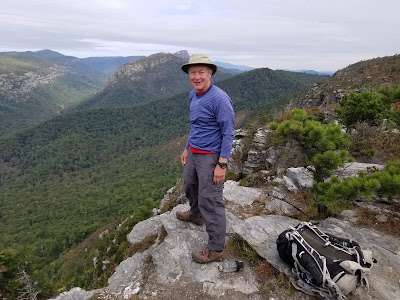 |
| Cliff Noyes, 89, still getting it done |
I used to think I was in pretty decent shape, at least for a guy in his 60s.
But then one day I tried to hike with the Washington, D.C., metropolitan area-based Tuesday Vigorous Hikers group and learned just how wrong I was.
The group of mostly senior adventurers—with regulars ranging in age of up to 81–left me in the dust by the time I had cleared the first rise out of the parking lot.
That was the last I saw of them that day, and no wonder. Their weekly workout consists of a 15 to 20-mile trek, with 3,000 to 5,000 feet of elevation gain, at a pace averaging up to 3.5 miles per hour, says Dave Green, 67, one of the group’s coordinators.
“Tuesday hikes are for hikers in good condition,” the group advises on its web site: https://sites.google.com/site/tuesdayvigoroushikers/. “Age does not matter, but you should understand what it means to hike 16 or so miles with 3,000 feet or more of climbing.”
To get to the requisite fitness level, wannabes should start on easier terrain, veteran group members say.
“The optimal way to train for hiking and backpacking is to hike and backpack, but modestly at first and gradually building up,” says Robert Livezey, 76, a coordinator for the group.
A regular hiking program is also important, particularly for older adventurers. “If I skip a week, I know the next one will be harder,” says Gene Whitaker, 81, another coordinator for the group. “The objective should be to get some exercise and enjoy the outdoors … not to try to keep up with the fastest hikers in our group,” Whitaker says.
Cliff Noyes, 89, who originally launched the weekday hiking group more than 20 years ago, says he still often participates. He has no plan to retire from the hiking group, though has been hiking at half the distance and pace as group regulars recently.
On his to-do list for 2020: a two-week hike through Tuscany on the Via Francigena, an ancient pilgrimage route from France to Rome, with his three sons. “Maybe celebrate my 90th birthday trailside,” Noyes says.
The good news for the mere mortals among us is that the Potomac Appalachian Trail Club, Tuesday Vigorous Hiker’s sponsor, also sponsors hiking groups with more moderate ambitions.
One of the groups, Midweek Hikers, often offers shorter and longer-mileage versions of each week’s hike, with one of seven miles, say, and another of 14.
Another group, the Easy Hikers, offers weekly walks of three to five miles, according to PATC’s website, www.patc.net.
“My motto is, use it or lose it,” says Carol Christensen, 71, a 14-year veteran of the Vigorous Hikers group.
Couldn’t agree more.
Meanwhile, I’m still in training in hopes of being able to keep up with Christensen and the other hard-chargers in the Tuesday Vigorous Hikers some day.
 |
| Christensen |
 |
| Whitaker, regular at the 41-mile Hike Across Maryland |
 |
| Livezey |
 |
| Green |











